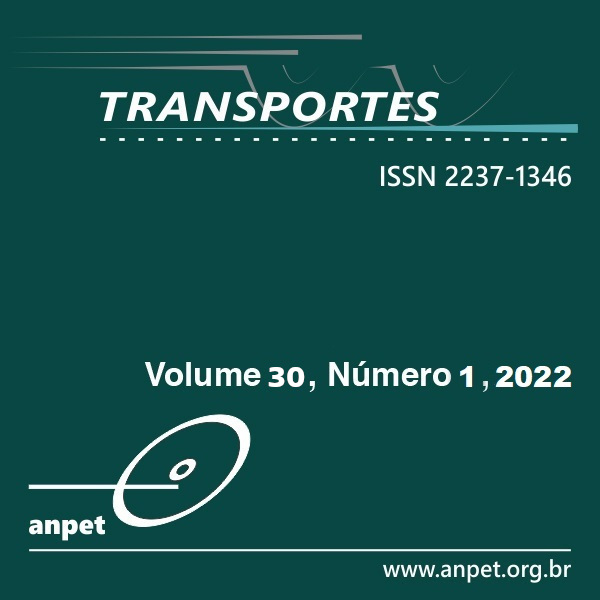Interface bond strength of geosynthetic-reinforced asphalt overlays and different asphalt emulsion rates
DOI:
https://doi.org/10.14295/transportes.v30i1.2632Keywords:
Geosynthetic, Pavement, Asphalt tack coat, Interface shearAbstract
The present study evaluated the behavior of geosynthetic-reinforced asphalt overlays using Leutner shear tests aiming on investigating different tack coat rates and the relationship of shear bond results with geosynthetics physical and mechanical properties. Therefore, samples were extracted from experimental sections combining 4 cationic rapid setting (CRS-2) emulsion rates and 3 reinforcement geocomposites (PET, PVA e Fiberglass). For all geosynthetics, results showed superior behavior of shear bond strength and interface shear stiffness as higher the applied emulsion rate. This increase was in the order of 129%, 73% and 146% for interface with PET, PVA and fiberglass reinforcement geocomposites, respectively. Asphalt retention capacity was not related to maximum shear bond strength, once higher tack coat rates were used. Geosynthetics physical properties presented influence over shear bond strength results, highlighting thickness, mass per unit area and geogrid mash sizes. Stiffer geosynthetics lead to lower bond strength results, while lead to higher interface shear stiffness. The influence of increase in tack coat rate was higher than the influence of geosynthetics physical and mechanical properties.
Downloads
References
ABNT (2013a) NBR ISO 10319: Geossintéticos - Ensaio de tração faixa larga. Rio de Janeiro: Associação Brasileira de Normas Técnicas.
ABNT (2013b) NBR ISO 9862: Geossintéticos - Amostragem e preparação de corpos de prova para ensaios. Rio de Janeiro: Associação Brasileira de Normas Técnicas.
ABNT (2013c) NBR ISO 9863-1: Geossintéticos - Determinação da espessura a pressões especifi cadas. Rio de Janeiro: Associação Brasileira de Normas Técnicas.
ABNT (2013d) NBR ISO 9864: Geossintéticos - Método de ensaio para determinação da massa por unidade de área de geotêxteis e produtos correlatos. Rio de Janeiro: Associação Brasileira de Normas Técnicas.
ASTM (2014) D6140: Standard Test Method to Determine Asphalt Retention of Paving Fabrics Used in Asphalt Paving for Full-Width Applications. West Conshohocken, PA: American Society for Testing and Materials International. DOI:10.1520/D6140-00R09.2.
Bae, A., Mohammad, L.N., Elseifi, M.A., Button, J. e Patel, N. (2010) Effects of Temperature on Interface Shear Strength of Emulsified Tack Coats and Its Relationship to Rheological Properties, Journal of the Transportation Research Board, 2180(1), pp. 102–109. DOI:10.3141/2180-12.
BS (1999) EN 1542: products and systems for the protection and repair of concrete structures. Brussels: British Standards.
Canestrari, F., Belogi, L., Ferrotti, G. e Graziani, A. (2015) Shear and flexural characterization of grid-reinforced asphalt pavements and relation with field distress evolution, Materials and Structures/Materiaux et Constructions, 48(4), pp. 959–975. DOI:10.1617/s11527-013-0207-1.
Canestrari, F., Ferrotti, G., Lu, X., Millien, A., Partl, M.N., Petit, C., Phelipot-Mardelé, A., Piber, H. e Raab, C. (2013) Mechanical Testing of Interlayer Bonding in Asphalt Pavements in Partl, M.N., Bahia, H.U., Canestrari, F., de la Roche, C., Di Benedetto, H., Piber, H. e Sybilski, D. (eds.) Advances in Interlaboratory Testing and Evaluation of Bituminous Materials. Dordrecht: Springer, pp. 303–360. DOI:10.1007/978-94-007-5104-0_6.
Canestrari, F., Ferrotti, G., Partl, M.N. e Santagata, E. (2005) Advanced testing and characterization of interlayer shear resistance, Transportation Research Record, (1929), pp. 69–78. DOI:10.3141/1929-09.
Chen, J.S. and Huang, C.C. (2010) Effect of surface characteristics on bonding properties of bituminous tack coat, Transportation Research Record, (2180), pp. 142–149. DOI:10.3141/2180-16.
Collop, A.C., Sutanto, M.H., Airey, G.D. e Elliott, R.C. (2009) Shear bond strength between asphalt layers for laboratory prepared samples and field cores, Construction and Building Materials, 23(6), pp. 2251–2258. DOI:10.1016/j.conbuildmat.2008.11.017.
Correia, N.S. and Mugayar, A.N. (2021) Effect of binder rates and geogrid characteristics on the shear bond strength of reinforced asphalt interfaces, Construction and Building Materials, 269. DOI:10.1016/j.conbuildmat.2020.121292.
DER (2006) ET-DE-P00/043: Tratamento Anti-Reflexão De Trincas Com Geossintético. São Paulo: Departamento de Estradas de Rodagem.
Destrée, A. e De Visscher, J. (2017) Impact of tack coat application conditions on the interlayer bond strength, European Journal of Environmental and Civil Engineering, 8189(March), pp. 1–12. DOI:10.1080/19648189.2017.1285252.
Ge, Z., Wang, H., Zhang, Q. e Xiong, C. (2015) Glass fiber reinforced asphalt membrane for interlayer bonding between asphalt overlay and concrete pavement, Construction and Building Materials, 101, pp. 918–925. DOI:10.1016/j.conbuildmat.2015.10.145.
Lee, S.L., Mannan, M.A. e Wan Ibrahim, W.H. (2020) Shear strength evaluation of composite pavement with geotextile as reinforcement at the interface. Geotextiles and Geomembranes, 48(3), pp. 230–235. DOI:10.1016/j.geotexmem.2019.11.002.
Leutner R (1979) Untersuchung des Schichtverbundes beim bituminösen Oberbau, Bitumen, 41(3), pp. 84–9.
Li, S., Huang, Y. e Liu, Z.H. (2016) Experimental evaluation of asphalt material for interlayer in rigid-flexible composite pavement, Construction and Building Materials, 102, pp. 699–705. DOI:10.1016/j.conbuildmat.2015.10.122.
Nguyen, M.L., Blanc, J., Kerzrého, J.P. e Hornych, P. (2013) Review of glass fibre grid use for pavement reinforcement and APT experiments at IFSTTAR, Road Materials and Pavement Design, 14(SUPPL.1), pp. 287–308. DOI:10.1080/14680629.2013.774763.
Noory, A., Moghadas Nejad, F. e Khodaii, A. (2019) Evaluation of the effective parameters on shear resistance of interface in a geocomposite-reinforced pavement, International Journal of Pavement Engineering, 20(9), pp. 1106–1117. DOI:10.1080/10298436.2017.1394094.
Pasetto, M., Pasquini, E., Giacomello, G. e Baliello, A. (2019) Innovative composite materials as reinforcing interlayer systems for asphalt pavements: an experimental study, Road Materials and Pavement Design, 20(sup2), pp. S617–S631. DOI:10.1080/14680629.2019.1628438.
Raab, C.. e Partl, M.N. (2004) Interlayer shear performance: Experience with different pavement structures, in 3rd Euroasphalt & Eurobitume Congress. Vienna: Foundation Eurasphalt, pp. 535–545.
Raab, C., Partl, M.N. e El Halim, A.E.H.O.A. (2009) Evaluation of interlayer shear bond devices for asphalt pavements, Baltic Journal of Road and Bridge Engineering, 4(4), pp. 186–195. DOI:10.3846/1822-427X.2009.4.186-195.
Rathmayer, H.G. (2007) Reinforcement of Pavements with Steel Meshes and Geosynthetics’ in Correia, A.G., Momoya, Y., e Tatsuoka, F. (eds) Design and Construction of Pavements and Rail Tracks: Geotechnical Aspects and Processed Materials. Balkema: Taylor & Francis, pp. 3–12. DOI: 10.1201/9780203937549.
Sagnol, L., Quezada, J.C., Chazallon, C. e Stöckner, M. (2019) Effect of glass fibre grids on the bonding strength between two asphalt layers and its Contact Dynamics method modelling, Road Materials and Pavement Design, 20(5), pp. 1164–1181. DOI:10.1080/14680629.2018.1439764.
Santagata, F.A.., Partl, M.N.., Ferrotti, G.., Canestrari, F. e Flisch, A. (2008) A. Layer characteristics affecting interlayer shear resistance in flexible pavements, Journal Association of Asphalt Paving Technologists, 77, pp. 221–256.
Sudarsanan, N., Karpurapu, R. e Amrithalingam, V. (2018) An investigation on the interface bond strength of geosynthetic-reinforced asphalt concrete using Leutner shear test, Construction and Building Materials, 186, pp. 423–437. DOI:10.1016/j.conbuildmat.2018.07.010.
Walubita, L.F., Nyamuhokya, T.P., Komba, J.J., Ahmed Tanvir, H., Souliman, M.I. e Naik, B. (2018) Comparative assessment of the interlayer shear-bond strength of geogrid reinforcements in hot-mix asphalt, Construction and Building Materials, 191, pp. 726–735. DOI:10.1016/j.conbuildmat.2018.10.035.
Yang, K. e Li, R. (2021) Characterization of bonding property in asphalt pavement interlayer: A review, Journal of Traffic and Transportation Engineering (English Edition) [Preprint]. DOI:10.1016/j.jtte.2020.10.005.
Yang, L., Roodi, G.H. e Zornberg, J.G. (2019) Development of a Shear Test for Unreinforced and Geosynthetic-Reinforced Hot Mix Asphalt, in Geosynthetics Conference. Houston, Texas, pp. 538–547. Disponível em: < https://www.caee.utexas.edu/prof/zornberg/pdfs/CP/Yang_Roodi_Zornberg_2019.pdf> (acesso em 21/03/2022)
Zhao, H., Cao, J. e Zheng, Y. (2017) Investigation of the interface bonding between concrete slab and asphalt overlay, Road Materials and Pavement Design, 18(sup3), pp. 109–118. DOI:10.1080/14680629.2017.1329866.
Downloads
Published
How to Cite
Issue
Section
License
Copyright (c) 2022 Gustavo Genaro Urquiza Júnior, Matheus Pena da Silva e Silva, Natália de Souza Correia

This work is licensed under a Creative Commons Attribution 4.0 International License.
Authors who submit papers for publication by TRANSPORTES agree to the following terms:
- The authors retain the copyright and grant Transportes the right of first publication of the manuscript, without any financial charge, and waive any other remuneration for its publication by ANPET.
- Upon publication by Transportes, the manuscript is automatically licensed under the Creative Commons License CC BY 4.0 license. This license permits the work to be shared with proper attribution to the authors and its original publication in this journal, and to be adapted for non-commercial purposes, provided appropriate credit is given and any derivative works are distributed under the same terms.
- Authors are authorized to enter into additional separate contracts for the non-exclusive distribution of the version of the manuscript published in this journal (e.g., publishing in an institutional repository or as a book chapter), with recognition of the initial publication in this journal, provided that such a contract does not imply an endorsement of the content of the manuscript or the new medium by ANPET.
- Authors are permitted and encouraged to publish and distribute their work online (e.g., in institutional repositories or on their personal websites) after the editorial process is complete. As Transportes provides open access to all published issues, authors are encouraged to use links to the DOI of their article in these cases.
- Authors guarantee that they have obtained the necessary authorization from their employers for the transfer of rights under this agreement, if these employers hold any copyright over the manuscript. Additionally, authors assume all responsibility for any copyright infringements by these employers, releasing ANPET and Transportes from any responsibility in this regard.
- Authors assume full responsibility for the content of the manuscript, including the necessary and appropriate authorizations for the disclosure of collected data and obtained results, releasing ANPET and Transportes from any responsibility in this regard.









